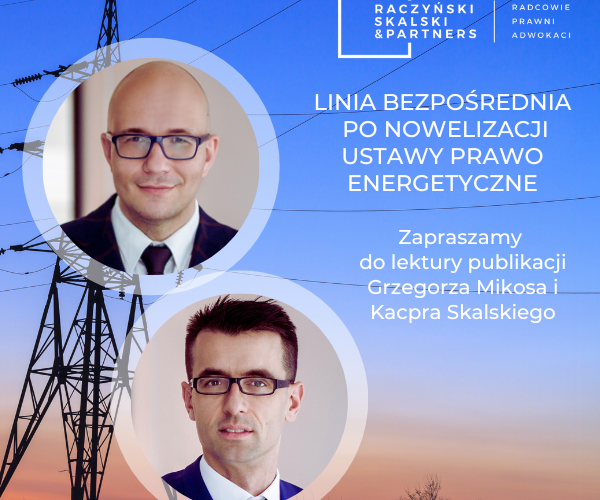Direct line – after amendments to the Energy Law Act
Direct line, under the previous legal status of the Energy Law, may have evoked associations with the Yeti – a mythical monster that, according to some Himalayan inhabitants, lives high in the mountains.
Everyone has heard of the direct line and more than one person has asked about it. However, there has been no evidence of its occurrence in business practice. Presumably, the ERO President has never approved the direct line. Even so, the direct line caused concern – mainly among distribution system operators.
The regulator was also worried about the direct line. It did not want a situation in which the largest industrial plants would be supplied with electricity bypassing the distribution and transmission network. In such a situation, the costs of maintaining the network would have to be borne more by tariff customers.
The regulator was also concerned about the direct line. It did not want a situation in which the largest industrial plants would be supplied with electricity bypassing the distribution and transmission network. In such a situation, the costs of maintaining the network would have to be borne more by tariff customers.
According to the previous wording of the Energy Law, the construction of a direct line required the approval of the ERO President in the form of a decision. Such approval had to be obtained before the issuance of a construction permit decision. It was assumed that the ERO President’s decision constituted a so-called preliminary issue to the proceedings conducted by the head of the district administration regarding the construction permit.
Amendments to the provisions of the Energy Law regarding direct lines were made by the Law of July 28, 2023.
On amending the Energy Law and certain other laws. This law on August 14, 2023 was signed by the President of the Republic of Poland and promulgated. In the direct line part, it will enter into force on September 7, 2023. In this article, we will look at the changes introduced.
New definition of direct line
According to the new Article 3(11f) of the Energy Law, a direct line will be a
- an electric power line connecting a separate generating unit with a separate customer for the purpose of directly supplying electricity to that customer (hereinafter: model 1), or
an electric power line connecting a generating unit with an electric power company, other than the generating unit, engaged in the business of electricity trading, for the purpose of directly supplying electricity to their own facilities,
including facilities or installations, entities that are their subordinate units within the meaning of the Law of September 29, 1994.
on accounting, or to customers connected to the networks, equipment or installations of these enterprises (hereinafter: model 2).
In connection with the change in the definition of direct line, new concepts were introduced into the Energy Law
- unbundled generation unit
that is, a generating unit from which all the electricity generated is covered by the direct supply of electricity to the unbundled customer;
NOTE
the concept of a generating unit has long been defined in the Energy Law. According to Article 3(43) of this Law, a generating unit is a separate set of equipment belonging to an energy company for generating energy and deriving power.
separated recipient
i.e. a customer who:
- is not connected to the electricity grid or
- is connected to the power grid in a way that prevents the introduction of electricity generated in a separated generation unit into the grid, or
- meets the conditions, technical requirements and obligations referred to in Article 7aa(3) of the Energy Law (this provision indicates the requirements whose fulfillment enables the introduction of energy supplied by a direct line into the grid);
Under the Energy Law, a customer is anyone who receives or consumes fuel or energy on the basis of a contract with an energy company. That is, re-invoiced entities are not considered customers.
Charges
The authors of the new solutions wanted to avoid a situation in which the largest, industrial energy consumers would use the direct line, while the “lion’s share” of the network maintenance costs would be passed on to households and small entrepreneurs. Therefore, a solution was introduced, according to which the use of the direct line will be associated with the obligation to pay to the network operator:
– a solidarity fee;
– a fee to cover the costs of maintaining system quality standards
and reliability of current energy supply[1].
Only those entities that cannot rely on energy from the distribution network because they are not connected to it are exempt from paying the aforementioned fees.
The need to bear the aforementioned fees must be taken into account when estimating the profitability of investment in a direct line. It seems that connecting a company to a direct line will not be the first choice solution. It will still be more cost-effective to connect a behind-the-meter (BTM) installation. However, the use of RES installations connected behind the meter, with sufficiently large capacity, is not possible everywhere
The method of determining the solidarity fee, as well as the method of determining the amount of the fee to cover the costs of maintaining system quality standards and reliability of current electricity supply, will result from the so-called tariff ordinance, i.e. an ordinance issued by the minister responsible for energy after consultation with the President of the ERO.
In the interim, until the tariff regulation, as amended, enters into force, fees are to be borne in the manner provided for in Article 34 of the amending law.
The new tariffs are to be submitted to the ERO President within a month of the entry into force of the tariff regulation – incorporating the amendments. The existing tariff regulation will remain in effect for 36 months at the longest from the effective date of the amendment.
Obligations of the entity entitled to the direct line
In accordance with Article 7aa (1) of the Energy Law, the basic obligations of the
of the entity holding title to a direct line include:
1) managing and maintaining the operation of the direct line;
2) ensuring continuity of supply and appropriate quality parameters of electricity;
3) promptly provide information, including metering and other technical data, at the request of this network operator or the President of the ERO;
4) installing and ensuring the proper operation of a metering and billing system that makes it possible to determine the amount of electricity supplied by a direct line;
5) enable the electricity system operator to read the metering data from the metering and billing system referred to above in order to make settlements and control the correct operation of the system;
6) update the information provided in connection with the notification
Importantly, the collection of electricity through a direct line does not restrict the customer’s right to connect to the electricity grid and collect electricity from the grid, provided that its equipment or installations prevent the introduction of electricity supplied through a direct line into the distribution or transmission grid to which the customer plans to connect.
The requirements for, among other things, how to ensure that the electricity generated in the unbundled generation unit cannot be exported to the operator’s grid, will be included in the instructions (IRiESP, IRiESD). It seems that devices, sometimes referred to as anti-pumping systems, will be applied.
The amendment law also indicates the criteria that must be met to inject electricity into the grid.
Electricity supplied by a direct line may be fed into the power grid if:
1) the conditions are met consisting in connecting the customer to the grid and concluding a distribution agreement and a power sales agreement;
2) the technical requirements specified in the regulations[2] are met;
3) a license for electricity trading has been granted.
An isolated generating unit, as well as any other generating unit supplying electricity through a direct line, must meet the requirements of the law in order to supply energy to the grid.
List of direct lines and expertise
Pursuant to Article 7aa (9) of the Energy Law, the ERO President maintains and publishes a list of direct lines in the ERO Public Information Bulletin.
An entity applying for the construction of a direct line or holding legal title to a direct line submits a notification to the ERO President of its intention to construct a direct line or to continue using a direct line. The scope of information to be included in the notification and the necessary attachments are indicated in the law.
According to the authors, of particular interest is the requirement to submit – along with the notification – an expert report on the impact of the direct line or the equipment, installations or networks connected to it on the electric power system. The expertise must be prepared by an entity that meets the criteria set forth in the law.
The scope of the expertise, the conditions for its execution and the main assumptions, including the necessary data, should be agreed with the power grid operator. The operator has an obligation to cooperate and a deadline for providing the data.
Energy market veterans may feel that history has come full circle. It used to be that an applicant for the connection of a RES source was required to provide such an expert opinion – based on assumptions provided by the operator. Subsequently, as a result of amendments to the Energy Law by the Law of January 8, 2010 amending the Energy Law and certain other laws, the obligation to prepare expert reports was transferred to operators and advances were introduced. Currently, the expert report on the impact on the grid prepared by the operator, although it is often the reason for refusing to connect a RES source to the grid, is a company secret. It cannot be obtained by requesting public information. Also, the President of the ERO refuses to inspect the expert report in the course of proceedings under Article 8 of the Energy Law.
The President of the Energy Regulatory Authority:
1) enters the direct line in the list on the basis of the application of the entity applying for the construction of the direct line or the entity holding legal title to the direct line, within 45 days from the date of submission of this application;
2) immediately after the direct line is entered in the list, issues a certificate of entry of the direct line in the list.
The entry shall be made in case of ascertaining the correctness of the information and scheme and ascertaining the absence of reasonable doubts about the negative impact of the direct line or the equipment, installations or networks connected to it on the power system on the basis of an expert opinion.
The ERO President, by decision, refuses to register the direct line in the list, among other things, if the expert opinion “indicates the negative impact of the direct line or devices, installations or networks connected to it on the power system, consisting in causing a threat to the security of electricity supply.”
Simplified procedure – for installations with a capacity of no more than 2 MW
In the simplified procedure, there is no requirement to submit an expert report. The ERO President shall make an entry in the list of direct lines only on the basis of the completeness and correctness of the information (the scope of which has been limited) and the diagram, in the case of a direct line that:
– will directly supply the electricity from the secreted generating unit to the installation and equipment of the secreted recipient of the unconnected to the grid a will directly supply the electricity to:
- the unbundled customer from the installation of renewable energy sources,
- an entity engaged in the business of trading in electricity for the purpose of direct supply to its own facilities, including equipment or installations, entities that are its subordinate units within the meaning of the Accounting Act, or to customers connected to the grid, equipment or installations of that enterprise
- as long as the facilities or installations do not allow the introduction of electricity supplied by a direct line into the distribution or transmission network, or the conditions, technical requirements and obligations conditioning the introduction of energy into the network have been met, and when the total installed capacity of the generating units is no more than 2 MW.
Summary
According to the authors, the amendment to the law, although long-awaited, will not be a milestone for the development of renewable energy sources in Poland. It will be limited by the results of expert reports on the impact on the grid. It should not be expected that the conclusions of the expert reports will be significantly different from those contained in the expert reports obtained by grid operators.
However, the new regulations offer hope for the development of new business models. When planning to invest in RES to meet one’s own needs, it is worth considering the opportunities provided by the new regulations. Particularly in a situation where there is no space on the company’s premises for further energy generation equipment to be connected behind the meter.
Authors: legal advisor Grzegorz Mikos and legal advisor Kacper Skalski of the law firm Raczynski Skalski Adwokaci i Radcowie Prawni spp.
[1] Pursuant to Article 7aa(4) of the amending law, a separate customer, except for a separate customer not connected to the electricity grid, or an energy enterprise engaged in the business of electricity trading, to which electricity is supplied from a generating unit by a direct line for the direct supply of electricity to its own facilities, including equipment or installations, entities that are its subordinate units within the meaning of Article 3(1)(42) of the Law of September 29, 1994. on accounting, or to customers connected to the network, facilities or installations of this enterprise, for electricity supplied by a direct line, shall pay to the energy enterprise engaged in the business of electricity transmission or distribution, to the network of which this customer or this enterprise is connected, a fee corresponding to the share of this entity in the fixed costs for electricity transmission or distribution, in the part not covered by other components of the tariff referred to in Art. 45, hereinafter referred to as the “solidarity fee,” which depends on the amount of energy supplied by this direct line, and the fee to cover the costs of maintaining system quality standards and reliability of current electricity supply, which depends on the amount of energy supplied by this direct line.
[2] These are the provisions contained in the so-called system regulation, i.e., the regulation issued pursuant to Article 9 (3) and (4) of the Energy Law, the legal acts issued pursuant to Articles 59-61 of Regulation 2019/943, and the methods, conditions, requirements and rules for technical requirements for generating units established pursuant to these legal acts.



